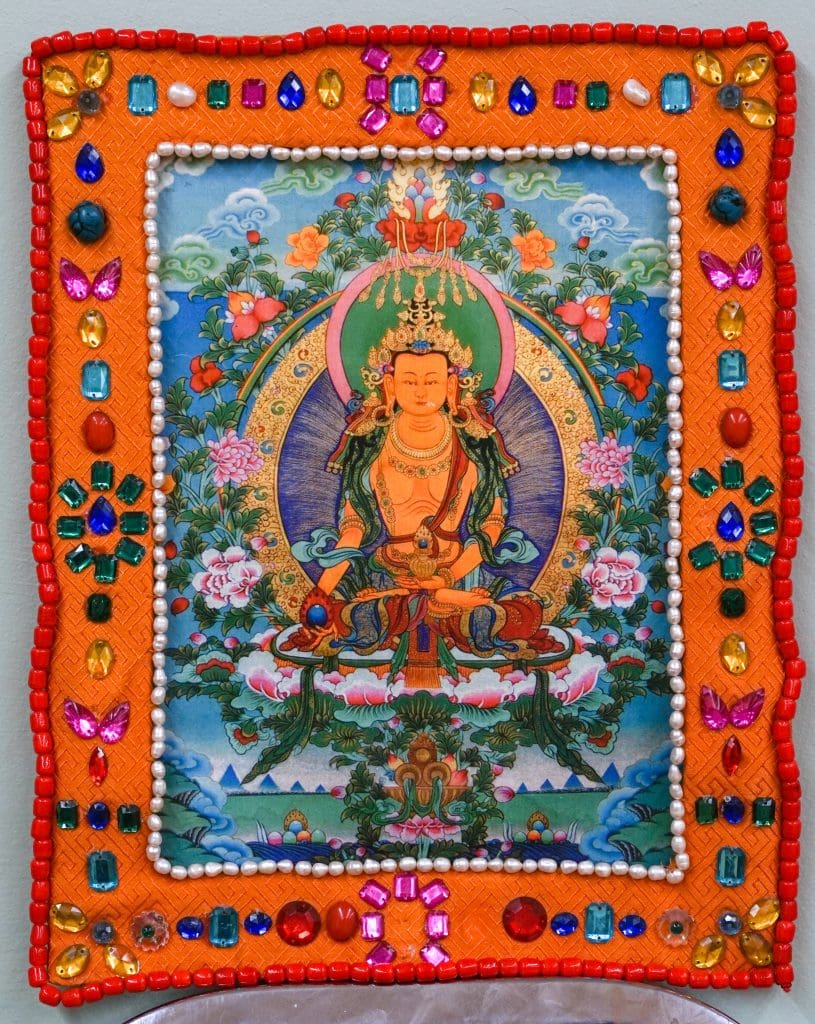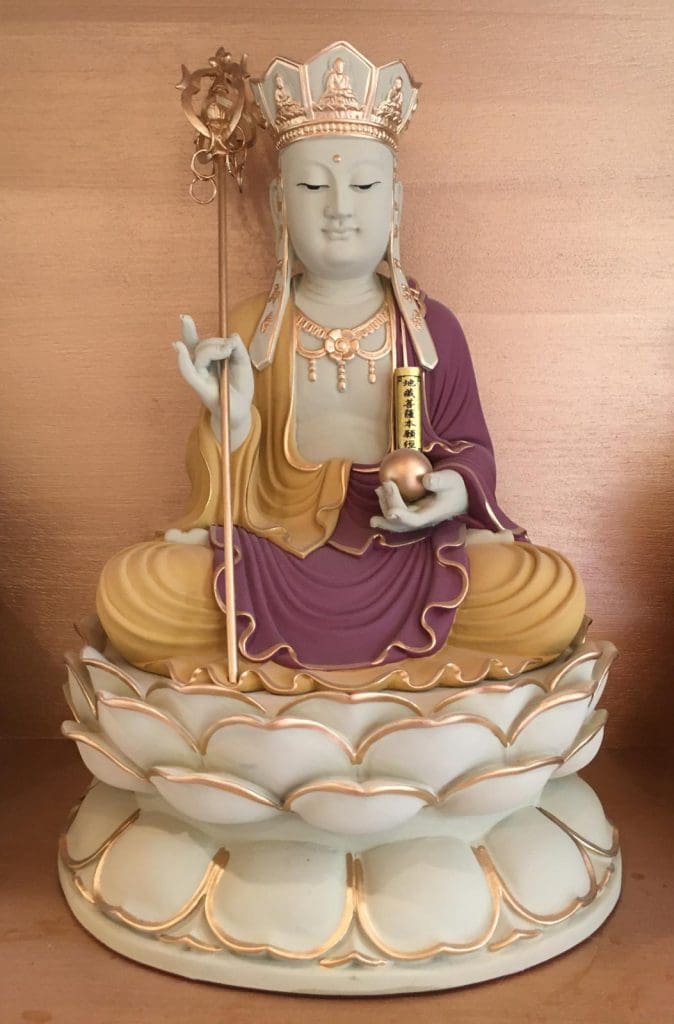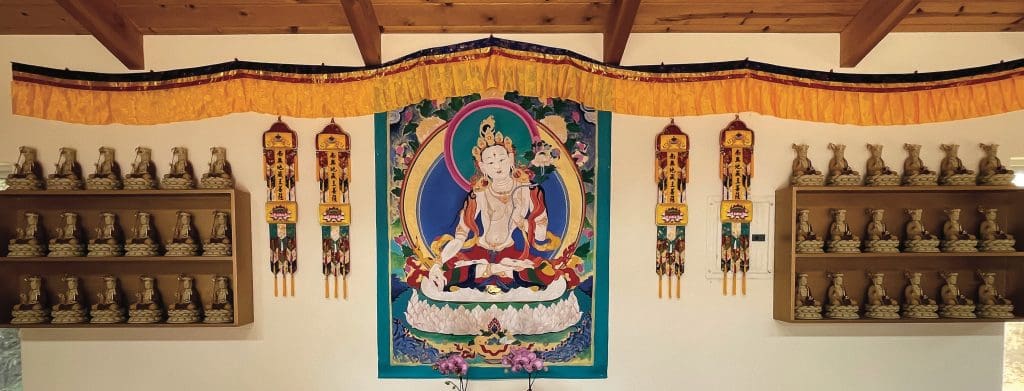In 2012, Lama Zopa Rinpoche bestowed the name “Kṣitigarbha Pure Land” to the hilltop area above the main campus. Upon it, sits a nine-foot Kṣitigarbha statue that has been a focal-point for visitors and pilgrims alike since 2008. It is also the site of our annual Kṣitigarbha Festival Day. Kṣitigarbha Temple, built in 2020, houses 108 beautiful 18-inch Kṣitigarbha statues and overlooks the Pure Land. The Kṣitigarbha Pure Land serves as a place of refuge for us to make offerings, practice, rejoice, and pray to Kṣitigarbha.
Join us in maintaining the Kṣitigarbha Pure Land to ensure the success of Land of Medicine Buddha, and Lama Zopa Rinpoche’s holy wishes, and dedicating to the good health and safety of all beings.

Kṣitigarbha is widely venerated in all traditions of Buddhism.
In the Chinese Mahayana tradition, he is known as Di Zang Wang Pu Sa (地藏王菩薩), Earth-Store Bodhisattva or Earth Treasure Bodhisattva. Also known as the “King of Great Vow,” he famously made the great vow, “If the hell is not empty, I shall not attain buddhahood.” His great vows are recorded in the popular sutra, Original Vows of Kṣitigarbha Bodhisattva Sutra, a Mahayana sutra spoken by Shakyamuni Buddha in the Trayastrimsa Heaven, where the Buddha went towards the end of his life and taught the Dharma in order to repay the kindness of his mother, Queen Maya. The sutra illustrates how Kṣitigarbha became a bodhisattva and recounts his efforts when he was a brahma woman in a previous existence, who sought the buddha’s help in freeing her mother from a suffering rebirth.
In the Japan, he is known as Jizo, relied upon by those who have lost their children, born or unborn. His name in Tibetan, Sa yi nying po (ས་ཡི་སྙིང་པོ), translates as “Essence of Earth.” He is one of the great eight bodhisattvas in the entourage of Shakyamuni Buddha.
Lama Zopa Rinpoche recommends reciting the Kṣitigarbha mantra and doing his practice to improve health and financial problems and also to avert disasters, such as earthquakes, hurricanes, and fires.
Rinpoche explains the benefits of relying on Ksitigarbha:
This practice is especially beneficial for those who have insurmountable problems, serious health problems, difficulties in big projects, and financial difficulties. I suggest they should recite either the long or the short mantra every day for protection, or at least four or five times or more, depending on the magnitude of the problems. This practice is also effective for people who want a good yield of their crops, and protection of their harvest and land. In the sutra of the bodhisattva Kshitigarbha are explained the extensive benefits that can definitely fill up the sky.
By making offerings to bodhisattva Ksitigarbha, whatever prayers you make become most unbelievably powerful—a hundred million times more powerful for success, and it is much more powerful than praying to other bodhisattvas. It is the most unbelievable for great success to happen as quickly as possible.
Thus Lama Zopa Rinpoche often advises that prayers to Ksitigarbha are much more powerful than those made to other bodhisattvas, emphasizing in the Kṣitigarbha Practice: “This mantra dharani is the best one to do for any problems in any situation. Even reciting four or five times, just a few times, is very powerful. [The sutra] talks about so much power, how important the bodhisattva is; even reciting or just thinking of the name of the bodhisattva is very, very powerful.”

Reciting Holy Name
南無地藏王菩薩 Na mo da di zang wang pu sa (in Chinese)
Homage to Kṣitigarbha Bodhisattva
Mantras
OṂ ĀḤ KṢITIGARBHA THLIṂ HŪṂ
Practice and Sutras
Kṣitigarbha Practice – compiled by Lama Zopa Rinpoche, contains the Ksitigarbha long mantra from the Daśacakra kṣitigarbha nāma mahāyāna sūtra
108 Names of Arya Kṣitigarbha and the Dharani Mantra – contains the Kṣitigarbha middle-length mantra
Kṣitigarbha Ten-Wheel Sutra from the Mahayana Collection – In the wide-ranging discourse of the Kṣitigarbha Ten Wheels Mahayana Sutra, the Buddha expounds on the “ten wheels” that define a just king’s rule; the knowledge and qualities of a tathagata; the ethics, conduct and practices to be adopted by the Buddha’s ordained followers; the features and qualities of the three vehicles; the practice of confession; the ten virtues and their ripening results; and the ten perfections.
The bodhisattva Kṣitigarbha, for whom the sutra is named, features most prominently in the first two chapters of the sutra. Alongside the inspiring description of his inconceivable qualities is an account of the exceptional benefits of the mantra dharani which he received. The sutra tells us: “he is greater than all other bodhisattvas, and you should make offerings to him with great devotion.”

Kṣitigarbha Temple houses 108 beautiful 18-inch Ksitigarbha statues.
These statues can be adopted in order to create merit for a loved one or for someone who has passed away.
Adopt a Kṣitigarbha statues with a sponsorship of $1080, or make a general donation here:
A variety of programs take place at Kṣitigarbha Pure Land and the Wish-Fulfilling Temple, such as the following:
- Waterbowl offerings
- TCM Clinics
- Tai Chi classes
Program information is available on our All Programs page. Visit here for further information.


